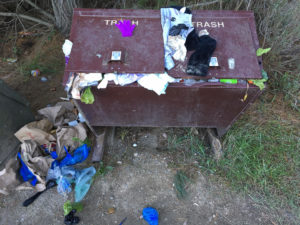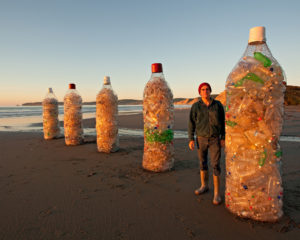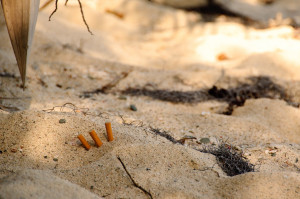It’s early on a weekday morning, and Chris Pincetich is sifting through a small pile of debris on Stinson Beach. He’s at the high-water mark, called the wrack line. That’s where buoyant ocean flotsam gets stuck as the tide goes out. As we walk along, he stops and points out how plastic strapping looks a lot like weathered eelgrass. Pincetich isn’t your ordinary beachcomber. He’s a scientist trying to compile a local data set for a global problem: marine plastic pollution.
“Usually I just sort of shuffle through the wrack line,” Pincetich says. Today, though, he’s busy training Kari Gehrke, a San Francisco State University student on her way to an internship in Costa Rica. She’ll be working with a sea turtle conservation group there and, on the side, doing some beach plastic surveys. Along with Gehrke, 10 freshmen from the Marin School of Environmental Leadership will be meeting here to learn how to do plastic surveys.
A year ago, Pincetich started monitor-ing plastic pollution on six beaches at Point Reyes. He set up transects, or measured grids, that he visits regularly to collect data before carting away marine debris. Since he started the study, he’s recorded more than 4,000 items of plastic on Point Reyes’s remote beaches. The goal, Pincetich says, is to document the density and type of local plastic pollution and then use that data to inform larger conservation efforts.
Pincetich started cleaning beaches with environmental groups like Surfrider as a kid. In college he majored in marine biology and studied pesticide runoff’s effects on salmon for his doctorate. He worked at water quality labs but missed the beach. So four years ago, he joined the Turtle Island Restoration Network to work on sea turtle conservation. “The nexus of toxicology and sea turtle conservation is plastic pollution,” Pincetich says. Sea turtles, including leatherbacks that migrate just offshore, forage near the ocean’s surface and are especially susceptible to ingesting or getting tangled in floating plastic.
Pincetech sets up his transect by measuring 100 meters parallel to the water and then recording debris at four points along that line. Once established, the starting point is always the same for each beach, but the sampling interval along the 100-meter transect will vary, at random. “When you are doing ecological transects you don’t just do the hot spots; you try to be objective and look at the whole area,” Pincetich says.
His goal is to understand what kinds of plastic items wash up on local beaches and where they come from, whether local sources or the global marine plastic mix. So far the study is revealing useful insights; for instance, shotgun shell casings (presumably from duck hunters) are among the most common plastics found on Bay Area beaches.
Early on, Pincetich realized that plastics don’t wash ashore randomly– deposition varies by location and season. “In the spring in Drakes Bay you can go to the beach and see plastic confetti everywhere,” he says. “In the summer, the current shifts and you don’t see the confetti as much.” That knowledge could help groups schedule beach cleanups when they’ll have the most impact.
Late in 2011, Pincetich’s study expanded to include sites beyond Point Reyes: Stinson Beach, Point Richmond, Crissy Field, and Fort Baker. He’s also sharing data with the National Oceanic and Atmospheric Administration’s local marine debris team, which is now using the same format to collect data, allowing easier collaboration.
Pincetich envisions a time when communities up and down the West Coast survey beaches to create a full picture of the marine plastics problem. “Ideally, millions of people would be doing this,” he says. But for now, and with the help of two interns, he’s sifting through a year of data and posting it at seaturtles.org. “The idea behind the survey,” he says, “is to go beyond the anecdotal stories and the graphic photos and use comparable data to paint a real picture of the plastics problem.”
More at seaturtles.org/plastics. Join the world’s biggest cleanup on Coastal Cleanup Day (info: bit.ly/3Sti6).





